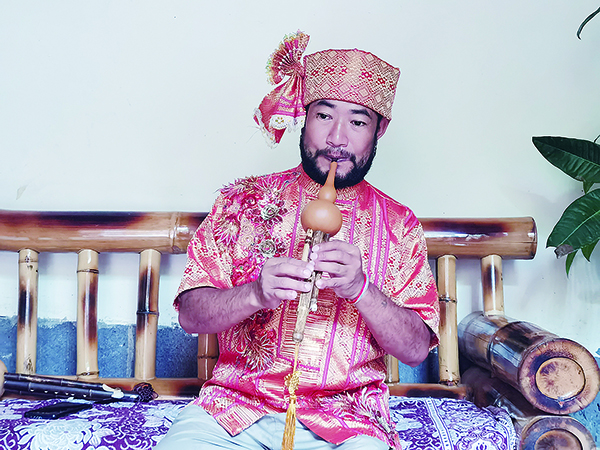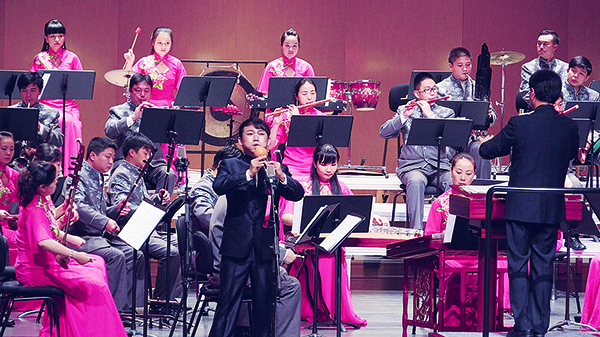Let the culture of cucurbit silk survive and pass on from generation to generation
For thousands of years, countless cucurbit flute performers, artists and enthusiasts in Lianghe County have continued to study and explore, and have inherited it from generation to generation, making persevering pursuits and efforts for the prosperity and development of cucurbit flute culture. Miao Congguo playing cucurbit flute

Miao Congguo playing cucurbit flute
"Planting the seeds for the development of cucurbit silk"
"Dehong Prefecture Chronicles" records: In late March 1982, Gong Quanguo, a Dai performer from the National Song and Dance Troupe of Dehong Dai and Jingpo Autonomous Prefecture, participated in the National Ethnic Musical Instrument Solo Competition held in Wuhan by the Ministry of Culture, and won the first prize for playing cucurbit silk; In early June 1985, five young actors including Gong Quanguo went to Japan to visit and perform, and were widely praised...
"The cucurbit silk is a cultural heritage left by our ancestors, and I should put it on the art stage." On January 2, 1985, the "Worker's Daily" article "Stars in the Land of Peacocks" described Gong Quanguo's wishes.
Gong Quanguo was born in Nameng Village, Mangdong Town in 1949. He was nurtured by the culture and art of cucurbit silk since he was a child. After graduating from secondary school in 1970, he joined the Lianghe County Cultural Team; in 1977, he began to study cucurbit silk and widely absorbed the folk of the Dai people. Music material, and co-created the cucurbit flute solo "Deep Bamboo Forest" with the famous composer Yang Zixi. With this song as a turning point, a large number of excellent cucurbit flute performances were born.
Born in Banggai Village, Mengyang Town in 1958, Zhuang Dequan was known as the "Prince of Hulusi". He absorbed and learned from the experience of his predecessors, persistently studied the scale arrangement and range of Hulusi, and summed up and improved the Hulusi It has formed a stable set of experience, making the production and performance of cucurbit silk to an unprecedented height.
"In the 1970s and 1980s, the folk cucurbit flute enthusiasts in Lianghe County who had rich experience in production and playing skills summed up valuable experience in production and playing." Lianghe County Party Committee United Front Work Department (county According to the relevant personnel of the Ethnic and Religious Affairs Bureau, the cucurbit silk has been improved and promoted at this time.
One moment, one heart. In the history of the development of cucurbit silk culture in Lianghe, there are also a group of "predecessors" who love cucurbit silk culture, such as Sha Yongxing, Sha Yongming, Zhao Dean, Jin Sanyu, Feng Shaoxing, Du Deguang, etc., who have planted the seeds for the development of cucurbit silk today... …
"Let more people participate in the production and inheritance"
Bamboo shadow and breeze, the winding path leads to the secluded place is the cucurbit silk production studio of Micongguo.
Zhuo Congguo is the nephew of Zhuo Dequan and a true disciple of the peculiar art of playing. Influenced and influenced by the family environment since childhood, Mian Congguo has a strong interest and deep affection for the culture of Hulusi and Bau.
After more than 20 years of hard work, Micongguo has grown from a farmer to a non-genetic inheritor of Dehong cucurbit flute playing. He has formed his own unique style in the performance of ancient Dai folk tunes, and has been widely recognized and appreciated. praise.
In order to better develop the cucurbit silk culture, in 2002, Micongguo founded the cucurbit silk·Bau production studio; in 2003, he became the person in charge of the original cucurbit silk professional cooperative, and in 2014, he established the Miao's Luyuan Cucurbit Silk Culture Industry Development Co., Ltd. The company, while teaching skills, leads the villagers to plant gourds and vigorously develops the gourd silk industry.
In a corner of the studio, several young people are concentrating on hand-polishing the bamboo pipes and reeds of cucurbit silk. "The production process of cucurbit silk is very complicated. It has to choose bamboo, bake, select gourd, assemble, dry, and tune; the bamboo and gourd for making cucurbit silk are also very particular..." Mi Congguo introduced that it is entirely by hand It takes about three hours to make a cucurbit silk.
Although the process was arduous, under the influence and leadership of Micongguo, more and more young people joined the team to learn the culture of Hulusi and Bau; Hulu" escaped poverty.
"I hope more people can understand the cucurbit silk and feel our splendid national culture. I also hope that more people can participate in its production and inheritance, and pass on the national culture." This is not only the dream of the country, but also Liang Congguo's dream The expectations of the middle-aged generation of cucurbit flute culture inheritors and lovers in Hexian County. Ni Kaihong concert scene
Ni Kaihong concert scene
"Take the responsibility of inheriting culture"
In Lianghe, young people also actively play the role of advocates and practitioners of cucurbit flute culture. Ni Kaihong, a librarian of Lianghe County Cultural Center and a young cucurbit flute performer, is one of them.
Ni Kaihong was influenced by the culture of cucurbit silk since he was a child. At the age of 10, he learned from local old folk artists, and at the age of 14, he learned from Zidequan.
In Ni Kaihong's eyes, the development of this ancient musical instrument has become the crystallization of the wisdom of various nations. "The cucurbit silk can express the strong charm of the Dai nationality, and it can also show the characteristics of other ethnic groups." With this as his creative goal, Ni Kaihong began to travel between villages and villages, studying and exploring the cultural charm and musical characteristics of various ethnic groups. Create and play songs of national unity hymns.
In 2011, Ni Kaihong released the cucurbit flute performance album "Hometown of Lianghe", and in 2013 he released the classic song cucurbit flute performance album. The works "Flower Tube Skirt", "Munao Zongge·Hot", and the performance works "Celebrating the New House", "Song of De'angshan" and "Happy Alisu" contain the musical elements and characteristics of 5 kinds of ethnic minorities living in Dehong Prefecture, and are widely accepted by the industry. People and the public alike.
In addition to exploring the innovative development of cucurbit flute culture, Ni Kaihong also contributes his own strength in cultivating excellent cucurbit flute talents. He has been invited many times as a teacher of the "National Cucurbit Silica-Bawu Senior Teacher Teacher Training Class", and has cultivated a large number of outstanding teachers. He is a senior instructor of cucurbit silk, and has carried out professional training for cucurbit silk teachers in Beijing, Shanghai, Kunming and other places many times. The students of the professor have also won many awards in international, national and provincial competitions.
On June 23 this year, Ni Kaihong's cucurbit silk production and processing factory was officially put into production. The production of cucurbit silk has been "mechanized", which has led to the increase of income and wealth for the local people of all ethnic groups.
As a younger generation, Ni Kaihong is different from "predecessors" such as Gong Quanguo, Zhuo Dequan, and Miao Congguo - he has a better learning environment; but, like them, he is all in his own way. Carry forward.
"I have the responsibility to pass it on." Ni Kaihong said.
This is also the secret of the endless growth of the cucurbit silk culture in Lianghe County.
Involving the artist
Involving musical instruments
Guess you like
Hot news
- 01 The handsome guy in 1997 is so advanced in pulling erhu! Netizen: Come and "wash your ears"
- 02 The Simple Difference Between Guqin, Se, and Guzheng
- 03 Dulcimer exam and performance repertoire
- 04 The difference between the five-stringed lute and the four-stringed lute
- 05 The difference between cymbals and cymbals in ethnic musical instruments
 渝公网安备 50010702504639号
渝公网安备 50010702504639号